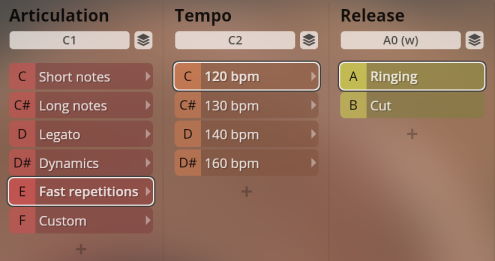Synchron World Winds
Introduction
The instruments of Synchron World Winds were recorded at Stage A, the main hall of Vienna’s revitalized Synchron Stage Vienna. The recordings were executed using an expansive, phase-controlled multi-microphone set-up, capturing the woodwinds played in a scoring stage with exceptional acoustics, now ready to be used in your studio. This document will provide you with the information you need to use the Library with our Vienna Synchron Player.
- Tin Whistles
- in G, range: G5-G7, scale: G Major (G, A, B, C, D, E, F#)
- in D, range: D5-D7, scale: D Major (D, E, F#, G, A, B, C#)
- in C, range: C5-C7, scale: C Major (C, D, E, F, G, A, B)
- in A, range: A4-A6, scale: A Major (A, B, C#, D, E, F#, G#)
- in F, range: F4-F6, scale: F Major (F, G, A, Bb, C, D, E)
- in low D, range: D4-D6, scale: D Major (D, E, F#, G, A, B, C#)
- Bansuris
- in E, range: E4-E6, scale: G Major (E, F#, G#, A, B, C#, D#)
- in D, range: D4–D6, scale: D Major (D, E, F#, G, A, B, C#)
- in A, range: A3–A5, scale: A Major (A, B, C#, D, E, F#, G#)
- Duduks
- in Bb, range: F3–C5, scale: Bb Major (Bb, C, D, Eb, F, G, A)
- in D (bass), range: G2–A#3, scale: D Major (D, E, F#, G, A, B, C#)
- Dizis
- in G, range: G4–G6, scale: G Major (G, A, B, C, D, E, F#)
- in D, range: D4–D6, scale: D Major (D, E, F#, G, A, B, C#)
- Gajdica in D, range: C4–E5, scale: D Major (D, E, F#, G, A, B, C#)
- Hulusi in C, range: C4–D5, scale: C Major (C, D, E, F, G, A, B)
- Koncovka in C, range: C4–A#6, natural scale: C4, G4, C5, E5, G5, A#5, C6, D6, E6, F#6, G6, A6, A#6
- Zurna in G, range: F4–A5, scale: G Major (G, A, B, C, D, E, F#)
- Shakuhachi, range: C4–D6, pentatonic scale: C, D, F, G, A

The recordings were executed using an expansive, phase-controlled multi-microphone set-up, capturing the woodwinds played in a scoring stage with exceptional acoustics, now ready to be used in your studio. This document will provide you with the information you need to use the Library with our Vienna Synchron Player.
Videos
Standard and Extended Library
All Synchron World Winds instruments were recorded using 11 microphones, subdivided into 7 sections. The Standard Library includes 4 of these sections (as well as a RAM-friendly Room Mix section composed of merged samples from the individual positions), allowing you to integrate instruments recorded with a stereo Decca tree into your projects using the Synchron Player software. Adding the Extended Library and thus getting the Full Library expands your possibilities to 5.1 surround and Auro 3D 9.1.
Microphone positions:
- Standard Library
-
- Room Mix – Stereo
-
- Close Mic – Mono
-
- Mid Layer Mic – Stereo (L/R)
-
- Main/Room Mic – Decca Tree Stereo (L/R)
-
- Main/Room Mic – Decca Tree Mono (Center)
-
- Extended Library
-
- Main Surround – Stereo (L/R)
-
- High Stereo (3D) – Stereo (L/R)
-
- High Surround (3D) – Stereo (L/R)
-

The instrument Presets also include different mixer presets. By default the classic room mixes are loaded which include the Standard Library microphone positions “Room-Mix”, “Close” and “Mid”. These are balanced in the stereo field to represent the respective instrument’s position in the Synchron Stage set-up.
Immersive Sound and Auro 3D
Auro 3D is an immersive audio technology that allows for three-dimensional sound perception. The Belgian company Auro Technologies developed this technology based on a special speaker configuration, adding four additional speakers to a 5.1 surround configuration. These speakers (so-called “Heights”) are situated above the front and surround speakers and generate acoustic reflections that are perceived naturally due to the fact that sounds originate from around as well as from above the listener. Thanks to the comprehensive selection of discrete audio channels with the Full Library, you may mix your instruments in Auro 3D as well as in Dolby Atmos.
Synchron Player Presets
The instrument Presets comprise all recorded Patches in articulation groups, which again contain types of the respective articulation, with further options if available. The general structure adheres to that of our other Synchron Collections, making it easy to switch or combine instruments without major adaptations.
Preset types
There are three basic Preset types for every instrument in separate folders marked “VelXF sus - MOD”, “VelXF- MOD”, and “Velocity”. In the regular “Velocity” presets, note volume is controlled by keystroke velocity just like a piano. In “VelXF” Presets, all articulations have velocity crossfading activated so that you can control dynamics with MIDI controller CC1, the modwheel. In “VelXF sus” Presets, however, velocity crossfading is only activated for long notes, while the dynamics of short notes are controlled by keystroke velocity, thus facilitating phrasing. Velocity crossfading can be enabled or disabled by clicking its on/off symbol in the Synchron Player's Perform tab.
The Synchron Player’s Timbre Adjust option is checked by default. Instruments with only one velocity layer (Tin Whistles, Duduks, Gajdica, Hulusi, Koncovka, Zurna) have CC1 assigned, so that in their VelXF and VelXF sus Presets, CC1 controls VelXF and Timbre Adjust simultaneously, enabling better dynamic play.
With other instruments, CC8 is assigned to Timbre Adjust control by default.
Sound categories
The Presets of an instrument are subdivided into several Articulation categories plus a “Custom” slot ready for your own creations. Generally (with exceptions according to instrument) these categories are:
- Short Notes
- Long Notes
- Legato
- Dynamics
- Fluttertongue
- Fast repetitions
Within these Articulation categories, you can select a Type, e.g., regular or long portato, and for some of the types there are additional options available, such as marcato or vibrato type control.
Articulations
Depending on your Synchron Player settings, Articulations may be disabled by default. Enabling an articulation means that all the types it contains will be activated, too, so if you happen to be short of RAM it is advisable only to activate what you really need (you can always add more types later).
By default the keyswitches for articulations are mapped starting from C1 (for Middle C = C4). For the available types, the keyswitches start from C2 for high instruments, and from C6 for low ones.
Additional options within articulations or types are offered by the Dimension Controllers. The controller function is indicated by the respective caption, as of course it may take on different tasks as needed.
Mixer Presets
Every instrument also features a number of Mixer Presets for stereo and surround microphone configurations that depict different recording situations: Close, Classic, Wide, Distant, Ambience, Lush, Lush long, Sparkling, and Catchy (the latter four only for stereo set-ups). Apart from that, you will also find Processed Standard Mixer Presets, which give you an idea of the possibilities and may present a good starting point for your own creations, as well as Signature Presets for Standard and Full Library.
Patches
Patches can be used to build your own custom Presets and adapt the Synchron Libraries to your specific requirements. For further information on constructing Presets, please see the Synchron Player manual.
Pitch
For designating pitch, the Vienna Symphonic Library uses International Pitch Notation (IPN), which was agreed upon internationally under the auspices of the Acoustical Society of America. In this system the international standard of A=440 Hz is called A4 and middle C is C4. All pitches are written as capital letters, their respective octave being indicated by a number next to it. The lowest C on the piano is C1 (the A below that is A0), etc.
The Synchron Player software allows you to set middle C to C3, C4, or C5 according to your preference. Selecting another setting than C4 will of course also change the play ranges and keyswitches accordingly.
01 Tin Whistles
The tin whistle belongs to the class of fipple flutes (like the recorder) and has six keyholes. It is often used in traditional Irish and Celtic music. In spite of their relatively high pitch, the sound of tin whistles is quite soft and lyrical. Typical playing techniques on the tin whistle are embellishments and bendings, which determine the special character of the instrument.
This set consists of 6 tin whistles with the following ranges and basic scales:
| Tuning | Range | Scale |
|---|---|---|
| G | G5–G7 | G, A, B, C, D, E, F# |
| D | D5–D7 | D, E, F#, G, A, B, C# |
| C | C5–C7 | C, D, E, F, G, A, B |
| A | A4–A6 | A, B, C#, D, E, F#, G# |
| F | F4–F6 | F, G, A, Bb, C, D, E |
| D low | D4–D6 | D, E, F#, G, A, B, C# |
A chromatic mapping with stretched intermediate tones is provided for all instruments. Interval legato was played chromatically with the help of special fingerings. One should bear in mind, though, that a chromatic live performance is not among the tasks one would normally ask from a tin whistle player.
- Articulation switches
- C1–D1
- Type switches
- starting at C2
Short notes
Staccato and portato bold and agile, and grace note portato.
- Bold/agile switch: A0/B0
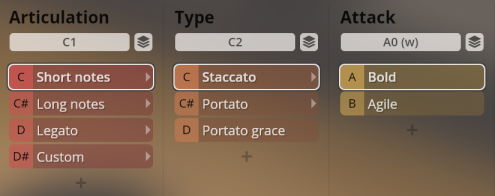
Long notes, Legato
Sustained notes and legato: regular, marcato, flutter tonguing; cut, tap, and roll ornament; octave grace notes (upwards or downwards depending on pitch), glissandos (grace), and upward slides (grace). All articulations except flutter tonguing and slides with and without vibrato.
With the vibrato crossfading option, use Dim.Ctrl/C (CC20) to control the vibrato amount.
- Vibrato options
- A2–B2
- Vibrato XF
- Dim.Ctrl/C (CC20)
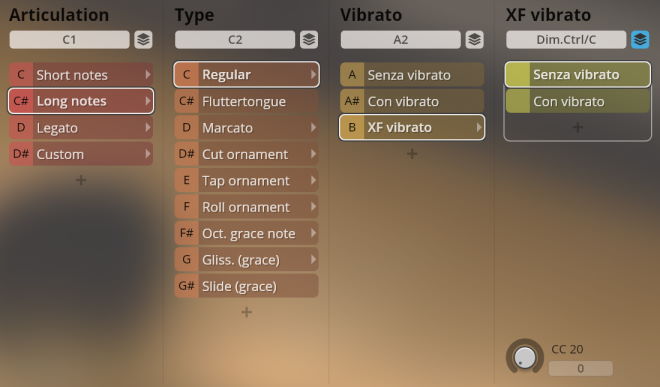
02 Bansuris
The bansuri is a side-blown flute from the Indian subcontinent, typically made from bamboo. It is used in Hindustani classical music. In comparison with the tin whistle, the bansuri’s character is stronger. Among other things, this is due to the fact that it has a wider dynamic range and is more at home in the alto register. The “exotic” sound is augmented by vibrato play and a characteristic downbending at the end of a note or phrase.
This set consists of 3 bansuris with the following ranges and basic scales:
| Tuning | Range | Scale |
|---|---|---|
| E | E4–E6 | E, F#, G#, A, B, C#, D# |
| D | D4–D6 | D, E, F#, G, A, B, C# |
| A | A3–A5 | A, B, C#, D, E, F#, G# |
A chromatic mapping with stretched intermediate tones is provided for all instruments. Interval legato was played chromatically with the help of special fingerings. Just like tin whistlers, chromatic live performances are not on the list of bansuri players’ common tasks.
Short notes
Staccato and portato bold and agile, long portato and short kana with and without vibrato, fast and slow falls.
Staccato, Portato
Staccato and portato bold and agile.
- Bold/agile switch: A0/B0
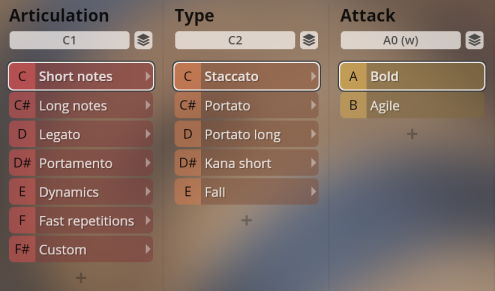
Portato long, Kana short
Long portato and short kana (an intermittent downward bend) with and without vibrato.
With the vibrato crossfading option (Portato only), use Dim.Ctrl/C (CC20) to control the vibrato amount.
- Vibrato options
- A2–B2
- Vibrato XF
- Dim.Ctrl/C (CC20)
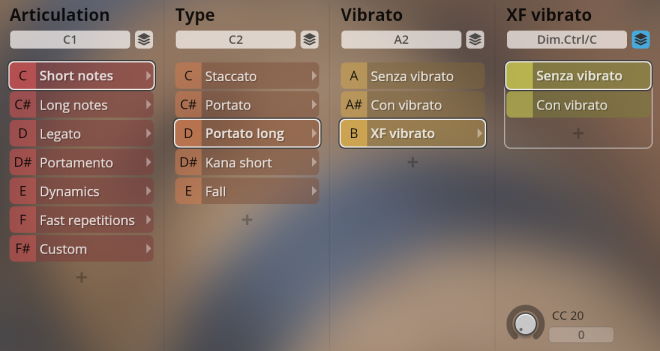
Fall
Fast and slow falls.
- Speed switch: A0/B0
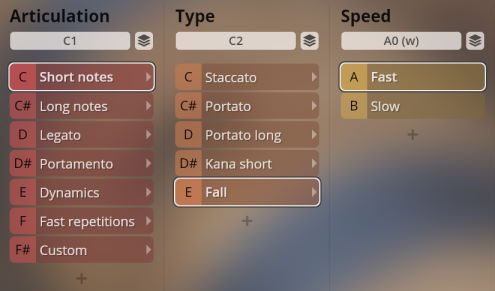
Long notes, Legato, Portamento
Sustained notes, legato, and portamento: regular, marcato, flutter tonguing, and kana. All articulations with and without vibrato, regular and fall release except flutter tonguing. As there is no legato or portamento flutter tonguing, these contain a copy of the long notes’ articulation.
With the vibrato crossfading option, use Dim.Ctrl/C (CC20) to control the vibrato amount.
- Vibrato options
- A2–B2
- Regular/fall release
- A0/B0
- Vibrato XF
- Dim.Ctrl/C (CC20)
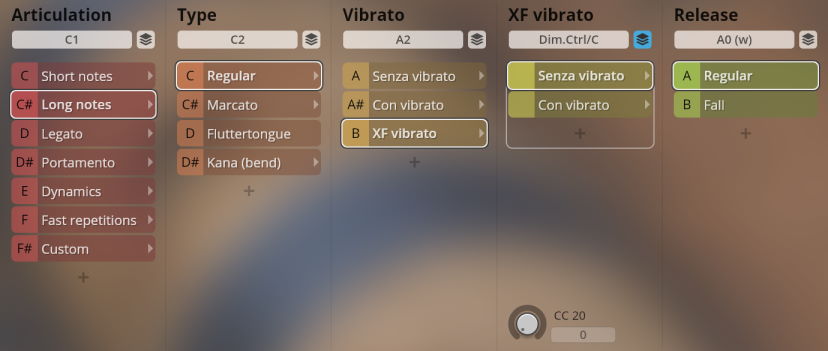
Dynamics
Crescendo and diminuendo, short and long, with and without vibrato.
With the vibrato crossfading option, use Dim.Ctrl/C (CC20) to control the vibrato amount.
- Vibrato options
- A2–B2
- Vibrato XF
- Dim.Ctrl/C (CC20)
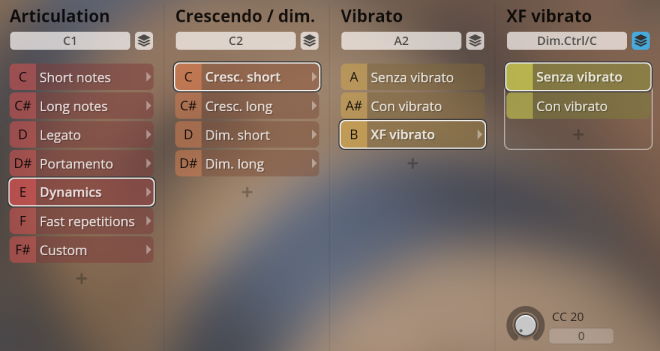
Fast repetitions
Fast repetitions from 120 to 160 BPM with ringing and cut release.
- Ringing/cut release: A0/B0
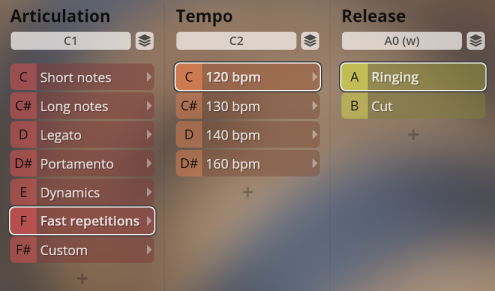
03 Duduks
The duduk is a double-reed instrument made from apricot wood and indigenous to Armenia. It sounds a bit like a softly played (tenor) saxophone. Its expressiveness results from sophisticated vibrato play and characteristical embellishments. Typically, duduk music is played by two musicians, with one player taking over the melody, the other playing a drone.
This set features 2 duduks:
| Tuning | Range | Scale |
|---|---|---|
| Bb | F3–C5 | Bb, C, D, Eb, F, G, A |
| D (bass) | G2–A#3 | D, E, F#, G, A, B, C# |
A chromatic mapping with stretched intermediate tones is provided for both instruments. Interval legato was played chromatically with the help of special fingerings on the duduk in Bb. On this model of bass duduk, onle the notes of the original scale can be played with regular playing techniques, and stretching in the mapping is not possible, so that the bass duduk can only play legato on the D major scale. Chromatic live performances are not on the regular menu of duduk players.
Type keyswitches: starting from C6
Short notes
Staccato and portato bold and agile, long portato with and without vibrato.
Staccato, Portato
Staccato and portato bold and agile.
- Bold/agile switch: A0/B0
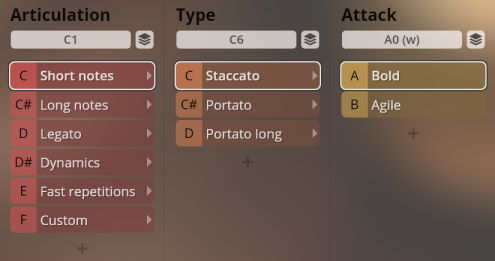
Portato long
Long portato with and without vibrato.
With the vibrato crossfading option, use Dim.Ctrl/C (CC20) to control the vibrato amount.
- Vibrato options
- A6–B6
- Vibrato XF
- Dim.Ctrl/C (CC20)

Long notes, Legato
Long notes and legato: regular without, with slow and fast vibrato; flutter tonguing, and trill. Long notes only: grace notes A and B with and without vibrato.
With the vibrato crossfading option, use Dim.Ctrl/C (CC20) to control the vibrato amount.
Regular
Sustains without, with slow and fast vibrato, as well as vibrato crossfading.
- Vibrato options
- A6–D7
- Vibrato XF
- Dim.Ctrl/C (CC20)
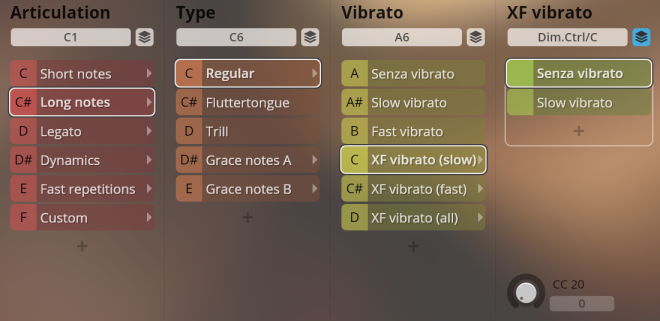
Grace (long notes only)
Grace notes A and B, with and without vibrato.
- Vibrato options
- A6–B6
- Vibrato XF
- Dim.Ctrl/C (CC20)
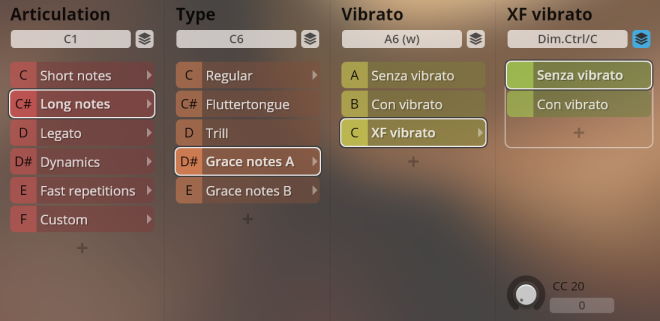
Portamento (bass duduk only)
Portamento without, with slow and fast vibrato.
With vibrato crossfading options, use Dim.Ctrl/C (CC20) to control the vibrato amount.
- Vibrato options
- A6–D7
- Vibrato XF
- Dim.Ctrl/C (CC20)
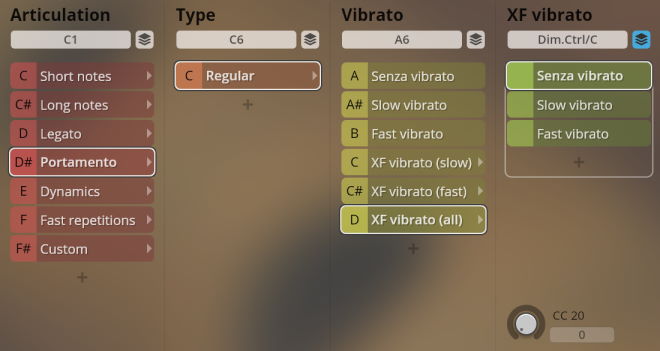
Dynamics
Crescendo with progressive vibrato.
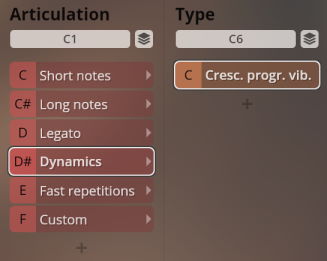
Fast repetitions
Fast repetitions from 120 to 160 BPM with ringing and cut release.
- Ringing/cut release: A0/B0
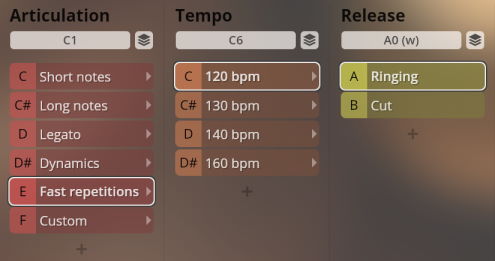
04 Dizis
The dizi is a Chinese transverse flute widely used in many genres of Chinese folk music, and also part of the modern Chinese orchestra. In the higher register, the dizi’s sound resembles that of a concert flute, while in the lower register the instrument has a very characteristic timbre with a distinct roughness to forte notes partly due to a membrane covering the topmost hole, similar to a kazoo. Characteristic playing techniques are manifold embellishments and overblowing at the end of a tone or phrase.
The set consists of 2 dizis with the following ranges and basic scales:
| Tuning | Range | Scale |
|---|---|---|
| G | G4–G6 | G, A, B, C, D, E, F# |
| D | D4–D6 | D, E, F#, G, A, B, C# |
A chromatic mapping with stretched intermediate tones is provided for both instruments. Interval legato was played chromatically with the help of special fingerings. As is the case with most folklore wind instruments, chromatic live performances do not belong to dizi players’ common tasks.
Short notes
Staccato and portato bold and agile, long portato with and without vibrato.
Staccato, Portato
Staccato and portato bold and agile.
- Bold/agile switch: A0/B0
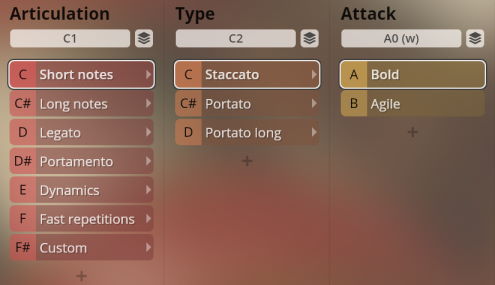
Portato long
Long portato with and without vibrato.
With the vibrato crossfading option, use Dim.Ctrl/C (CC20) to control the vibrato amount.
- Vibrato options
- A2–B2
- Vibrato XF
- Dim.Ctrl/C (CC20)
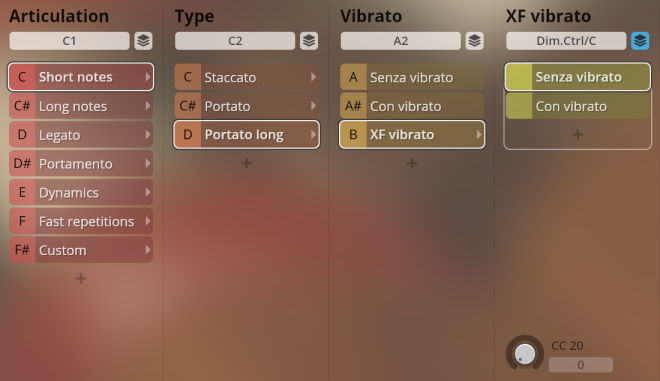
Long notes, Legato, Portamento
Long notes, legato and portamento with and without vibrato as well as regular and accentuated release.
With the vibrato crossfading option, use Dim.Ctrl/C (CC20) to control the vibrato amount.
Regular
Sustains, legato, portamento regular, marcato; half tone, whole tone, and trills in G/D major; half tone, whole tone, third and fourth gamaka (an Indian term referring to a movement done on a note or between two notes); grace (long notes only) – all with and without vibrato and regular and accentuated release; flutter tonguing with regular and accentuated release. Portamento contains a copy of the legato flutter tonguing.
- Vibrato options
- A2–B2
- Vibrato XF
- Dim.Ctrl/C (CC20)
- Release switch
- A0–B0

Flutter
Flutter tonguing with regular and accentuated release.
- Release switch: A0/B0
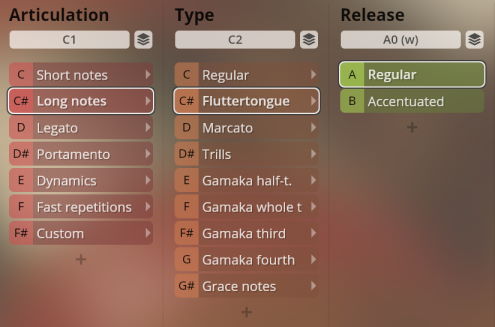
Trills
Half and whole tone trills, as well as trills on the G major scale, with regular and accentuated release.
- Trill type switches
- A2–B2
- Release switch
- A0/B0
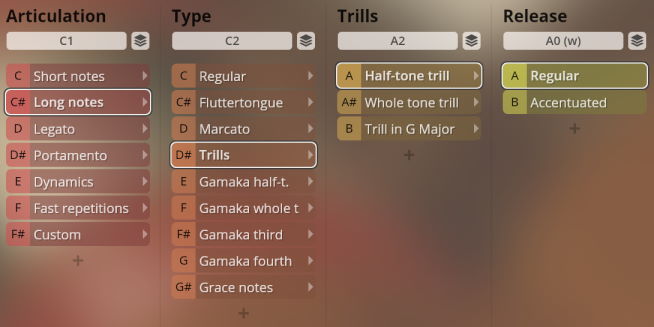
Dynamics
Crescendo and diminuendo, short and long, with and without vibrato.
With the vibrato crossfading option, use Dim.Ctrl/C (CC20) to control the vibrato amount.
- Vibrato options
- A2–B2
- Vibrato XF
- Dim.Ctrl/C (CC20)
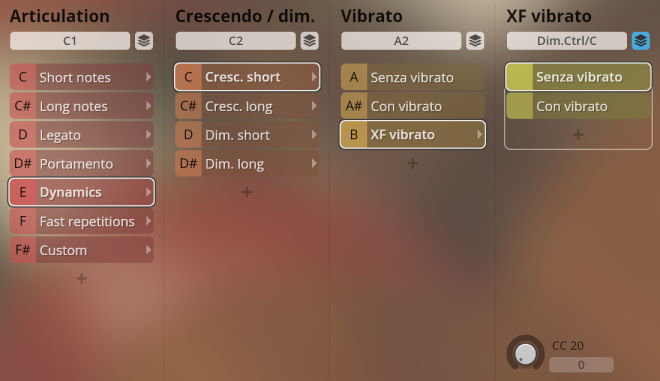
Fast repetitions
Fast repetitions from 120 to 160 BPM with ringing and cut release.
- Ringing/cut release: A0/B0
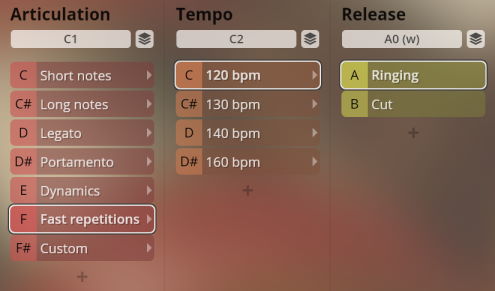
05 Gajdica
The gajdica is a Slovakian single-reed instrument, typically with an air capsule around the reed and a bell made of cowhorn. The sound of the gajdica is loud and intense, and like the bagpipe it is not amenable to subtle nuances. One of its features is a special kind of very quickly played vibrato which lends the instrument its unique character.
- Range: C4–E5
- Scale: D, E, F#, G, A, B, C#
A chromatic mapping with stretched intermediate tones is provided. Interval legato was played chromatically with the help of special fingerings. Like most folklore wind instruments, chromatic live performances are not among its common tasks.
Short notes
Staccato and portato bold and agile, long portato without, with regular and strong vibrato.
Staccato, Portato
Staccato and portato bold and agile.
- Bold/agile switch: A0/B0
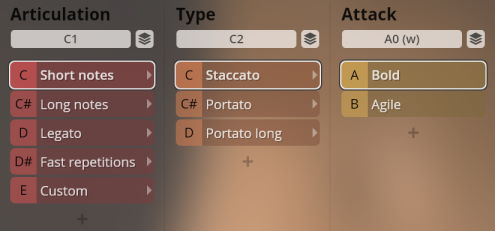
Portato long
Long portato without, with regular and strong vibrato.
With the vibrato crossfading option, use Dim.Ctrl/C (CC20) to control the vibrato amount.
- Vibrato options
- A2–D3
- Vibrato XF
- Dim.Ctrl/C (CC20)
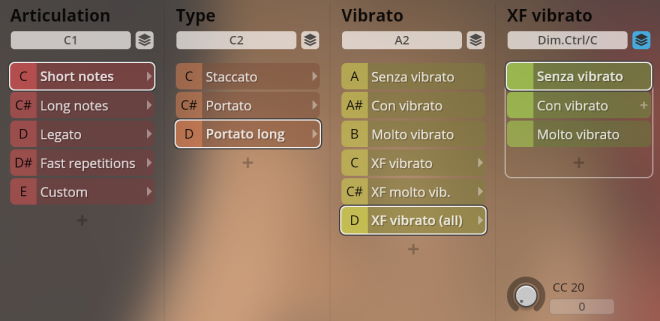
Long notes, Legato
Long notes and legato: regular, and grace notes without, with normal and strong vibrato; flutter tonguing and trills.
With the vibrato crossfading option, use Dim.Ctrl/C (CC20) to control the vibrato amount.
Regular
Sustains without, with slow and fast vibrato, as well as vibrato crossfading.
- Vibrato options
- A2–D3
- Vibrato XF
- Dim.Ctrl/C (CC20)
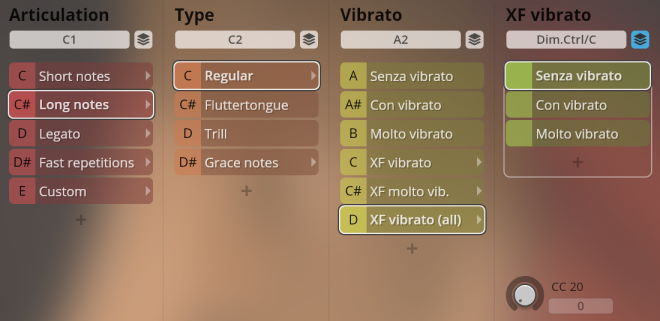
Fast repetitions
Fast repetitions from 120 to 160 BPM with ringing and cut release.
- Ringing/cut release: A0/B0
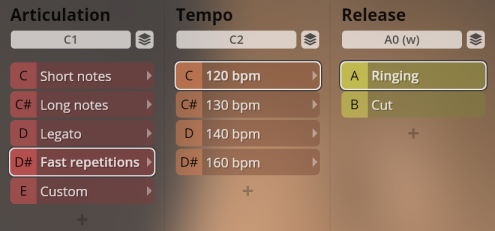
06 Hulusi
The hulusi is an Asian free reed instrument also known as a gourd flute, as its mouthpiece is encased in a hollowed-out bottle gourd. The sound of the hulusi can be compared with that of the bassoon, its sounds develop rather softly. Vibrato technique makes it very expressive, though.
- Range: C4–D5
- Scale: C, D, E, F, G, A, B
A chromatic mapping with stretched intermediate tones is provided. Interval legato was played chromatically with the help of special fingerings. Like most folklore wind instruments, chromatic live performances are not among its common tasks.
Short notes
Staccato and portato bold and agile; long portato without, with slow and fast vibrato; dynamic trill.
Staccato, Portato
Staccato and portato bold and agile.
- Bold/agile switch: A0/B0
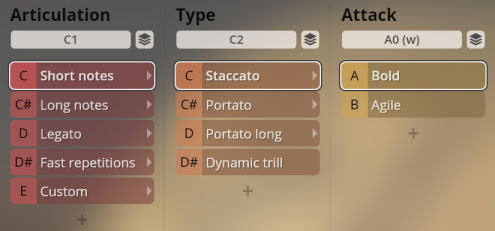
Portato long
Long portato without, with slow and fast vibrato.
With the vibrato crossfading option, use Dim.Ctrl/C (CC20) to control the vibrato amount.
- Vibrato options
- A2–D3
- Vibrato XF
- Dim.Ctrl/C (CC20)
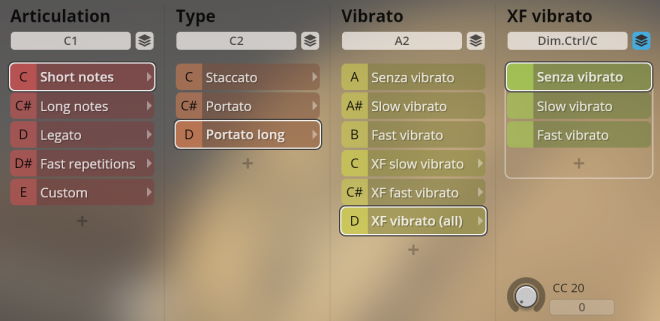
Long notes, Legato
Long notes and legato: regular without, with slow and fast vibrato, flutter tonguing, and trills. Long notes only: dynamic trills.
With the vibrato crossfading option, use Dim.Ctrl/C (CC20) to control the vibrato amount.
Regular
Sustained without, with slow and fast vibrato, as well as vibrato crossfading.
- Vibrato options
- A2–D3
- Vibrato XF
- Dim.Ctrl/C (CC20)
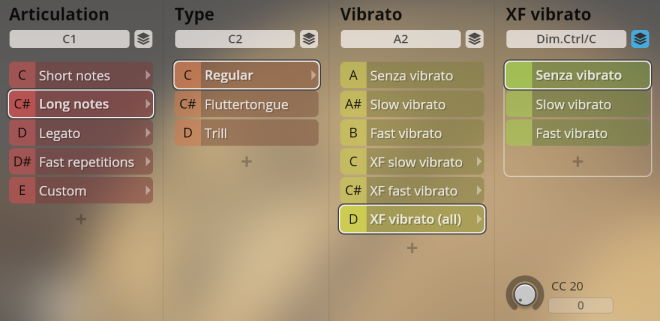
Fast repetitions
Fast repetitions from 120 to 160 BPM with ringing and cut release.
- Ringing/cut release: A0/B0
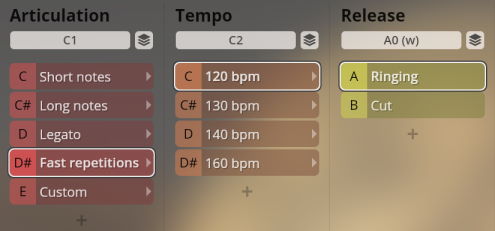
07 Koncovka
Like the fujara flute, the Slovakian koncovka is an instrument without keys or tone holes, making it a pure overtone instrument, where the intensity of the airstream determines volume and pitch at the same time. Because of this, the koncovka’s lowest tones are also its softest ones. A typical playing technique is overblowing at the end of notes and phrases.
- Range: C4–A#6
- Scale: C4, G4, C5, E5, G5, A#5, C6, D6, E6, F#6, G6, A6, A#6
A chromatic mapping with stretched intermediate tones is provided except for the fast repetitions where no satisfactory results could be achieved. Due to the koncovka’s limitation to harmonics, a scale-based legato patch is also impossible to realize. Instead, there are numerous phrases and building blocks facilitating virtuoso, rhythm-oriented programming.
Short notes
Staccato and portato bold and agile, long portato with and without vibrato, and staccato effects.
Staccato, Portato
Staccato and portato bold and agile.
- Bold/agile switch: A0/B0
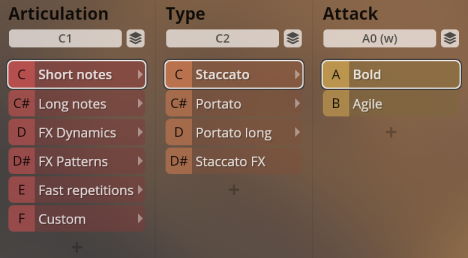
Portato long
Long portato with and without vibrato.
With the vibrato crossfading option, use Dim.Ctrl/C (CC20) to control the vibrato amount.
- Vibrato options
- A2–B2
- Vibrato XF
- Dim.Ctrl/C (CC20)
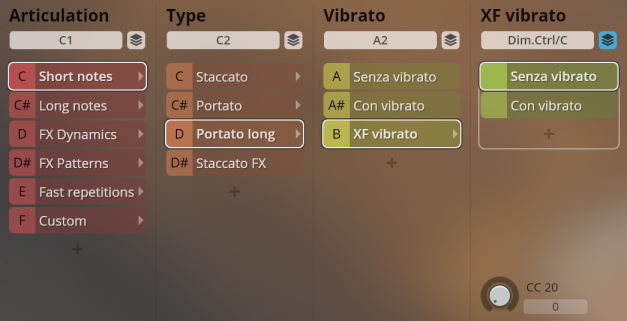
Long notes
Sustained notes regular without and with vibrato, flutter tonguing, glissando up and down. All articulations with regular and accentuated release.
With the vibrato crossfading option, use Dim.Ctrl/C (CC20) to control the vibrato amount.
- Release switch: A0/B0
Regular
- Vibrato options
- A2–B2
- Vibrato XF
- Dim.Ctrl/C (CC20)
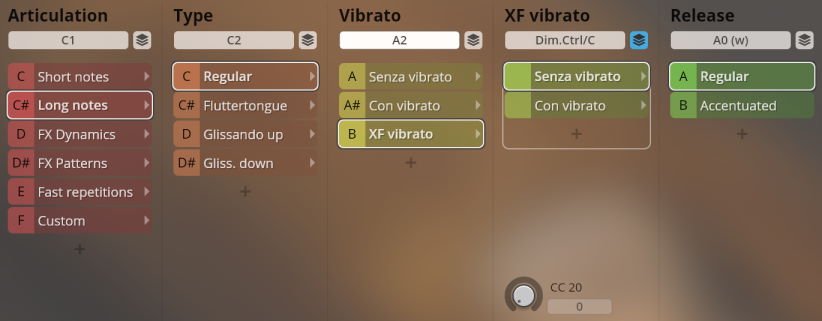
FX dynamics
Crescendo and diminuendo effects.
- Mapping: C4–D#4, F4–G#4, C5–D#5, F5–G#5
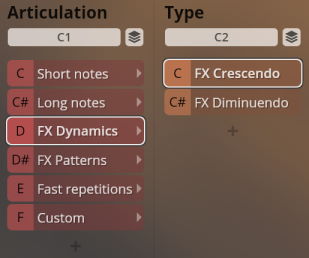
FX patterns
5 different effects patterns, and looped phrases. The pattern mappings include additional staccato notes, which can be used as release samples.
- Pattern mapping
- white keys C4–B4 (range depending on pattern)
- C5–A#6 single notes
- Loops mapping
- white keys C4/D4, F4–A4, C5–A5, C6/D6
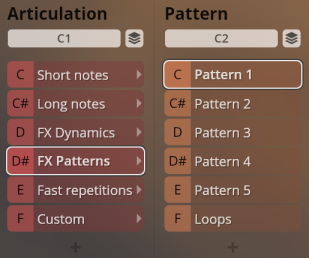
Fast repetitions
Fast repetitions from 120 to 160 BPM with ringing and cut release.
- Mapping
- C4, G4, C5–A#6
- Ringing/cut release
- A0/B0
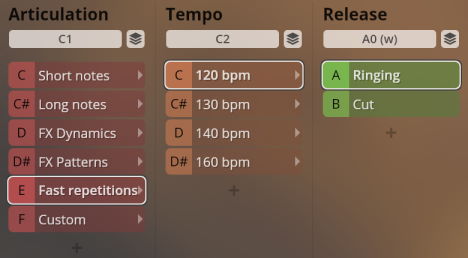
08 Zurna
The zurna is a double-reed instrument played throughout the Balkans, but similar instruments exist in Asia and North Africa. It is made from hardwood, often plum or apricot. A zurna must be able to project over big crowds in the open air, so it is a very loud instrument. Accordingly, it does not lend itself to subtler forms of expression.
- Range: F5–A5
- Scale: G, A, B, C, D, E, F#
A chromatic mapping with stretched intermediate tones is provided. Interval legato can only be played on the G major scale, as special fingerings cannot be executed on the zurna.
Short notes
Staccato and portato bold and agile, long portato with and without vibrato.
Staccato, Portato
Staccato and portato bold and agile.
- Bold/agile switch: A0/B0.
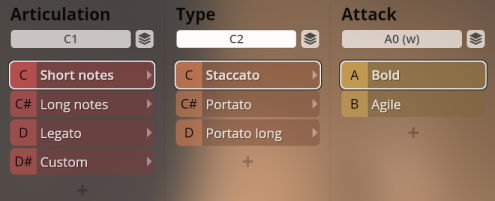
Portato long
Long portato with and without vibrato.
With the vibrato crossfading option, use Dim.Ctrl/C (CC20) to control the vibrato amount.
- Vibrato options
- A2–D3
- Vibrato XF
- Dim.Ctrl/C (CC20)
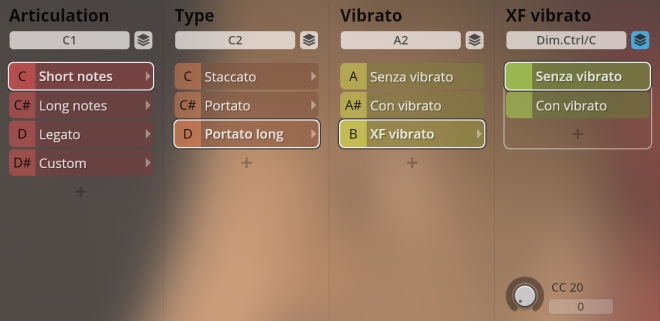
Long notes, Legato
Long notes and legato: regular, marcato, and grace notes (long notes only) with and without vibrato; flutter tonguing and trills.
With the vibrato crossfading option, use Dim.Ctrl/C (CC20) to control the vibrato amount.
Regular
Sustained with and without vibrato, as well as vibrato crossfading.
- Vibrato options
- A2–B2
- Vibrato XF
- Dim.Ctrl/C (CC20)
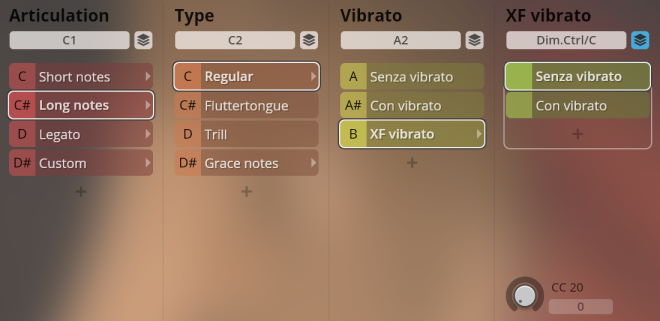
09 Shakuhachi
The Japanese shakuhachi is probably one of the best known East Asian instruments. The end-blown flute’s characteristic sound with the player’s blowing distinctly audible is unique and therefore unmistakable. Typical playing techniques for the instrument are embellishments and bending, as well as a marked attack on starting notes.
- Range: C4–D6
- Scale (pentatonic): C, D, F, G, A
The shakuhachi was mapped chromatically with stretched intermediate tones. Interval legato was played chromatically with the help of special fingerings. However, chromatic live performances are not part of shakuhachi players’ standard repertoire.
Short notes
Staccato and portato bold and agile, slow and fast portato marcato, short grace notes without, with regular and with head vibrato; dynamic trills.
Staccato, Portato
Staccato and portato bold and agile.
- Bold/agile switch: A0/B0
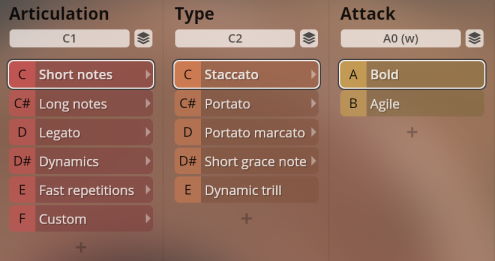
Portato marcato
Slow and fast portato marcato.
- Slow/fast switch: A0/B0
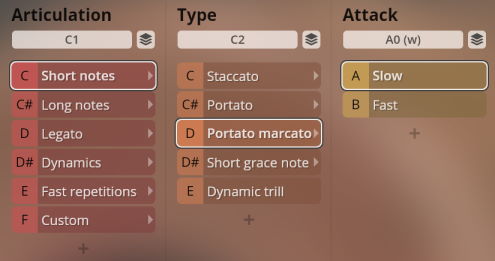
Short grace note
Short grace notes without, with regular and with head vibrato.
With the vibrato crossfading option, use Dim.Ctrl/C (CC20) to control the vibrato amount.
- Vibrato options
- A2–D3.
- Vibrato XF
- Dim.Ctrl/C (CC20)
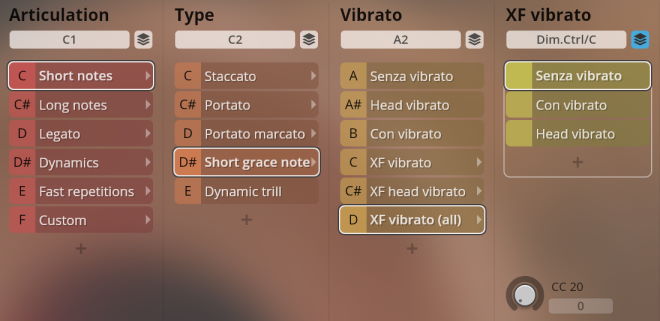
Long notes, Legato
Long notes and legato: regular without, with head and regular vibrato; marcato, grace notes, and espressivo (long notes only) with and without vibrato; flutter tonguing, and trills. All with regular, fall, and accentuated release.
With the vibrato crossfading option, use Dim.Ctrl/C (CC20) to control the vibrato amount.
- Release switch: A0–B0
Regular
Sustains without, with head and regular vibrato, as well as vibrato crossfading.
- Vibrato options
- A2–D3
- Vibrato XF
- Dim.Ctrl/C (CC20)

Marcato, Grace notes, Espressivo
Marcato, grace notes, and espressivo with and without vibrato.
- Vibrato options
- A2–C3 (white keys)
- Vibrato XF
- Dim.Ctrl/C (CC20)
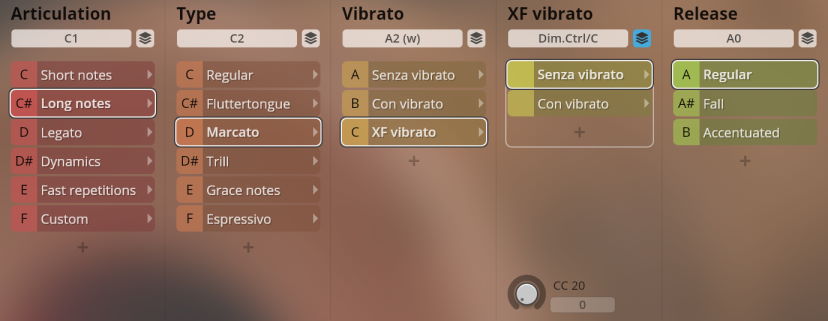
Flutter tonguing, Trills
Flutter tonguing and trills with regular, fall, and accentuated release.
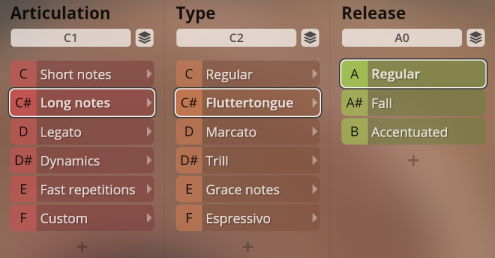
Dynamics
Crescendo and diminuendo with and without vibrato.
- Vibrato options
- A2–C3 (white keys)
- Vibrato XF
- Dim.Ctrl/C (CC20)
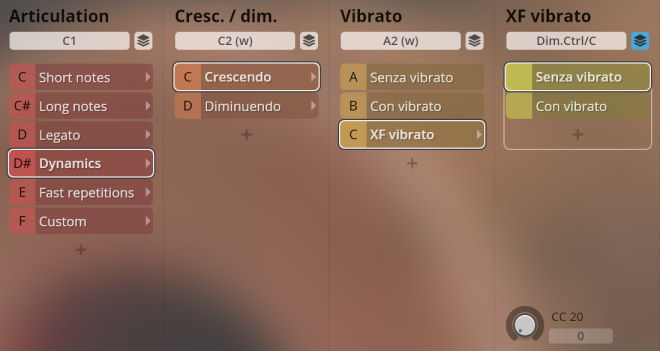
Fast repetitions
Fast repetitions from 120 to 160 BPM with ringing and cut release.
- Ringing/cut release: A0/B0
